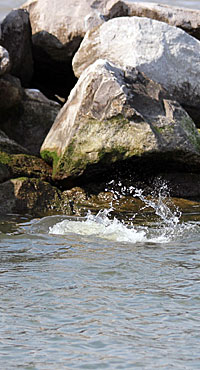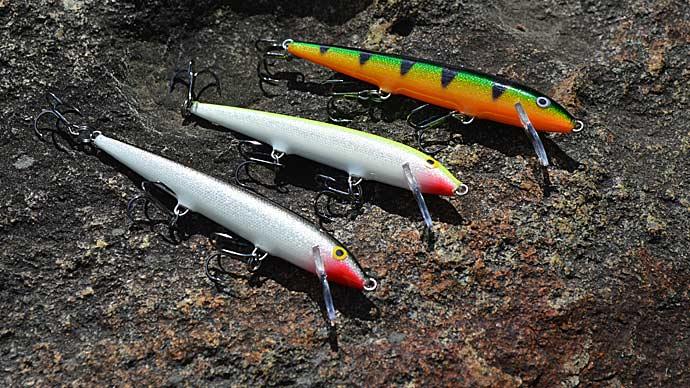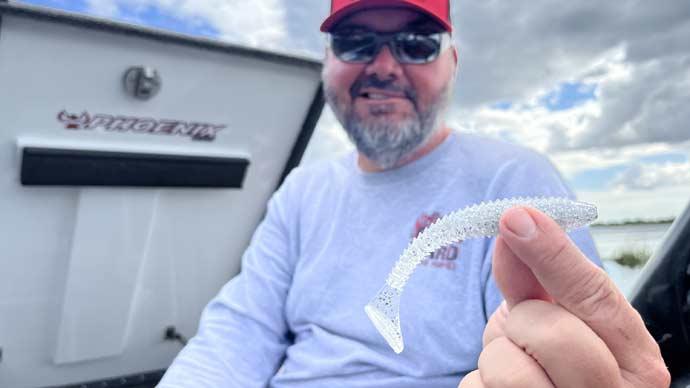
Bass anglers often fly wide open right past one of the best locations on almost any lake, and it’s so easy to see that even non-fishermen know where to find it. It’s riprap, those rocks and chunks of concrete stacked along shore to prevent erosion, and there are a bunch of reasons bass love it.
Riprap creates a great spawning site for shad during the late spring, and produces the algae these baitfish feed on during summer and fall. Other forage such as crawfish and aquatic insects also makes their homes in the rocks. Just the food factor alone makes riprap a productive bass fishing hotspot.
“What’s neat about riprap is that bass use it multiple times throughout the year,” said Alabama guide and tournament angler jimmy Mason. “I start fishing riprap in winter and catch bass off of it throughout the year with the exception of the hottest summer days.”
Mason guides anglers on Guntersville and Wilson Lakes, and said that he may spend less time fishing riprap on his home lakes than when fishing a tournament on a less familiar body of water. That’s because each stretch of riprap features only a few hotspots, and once these sweet spots are located they can be quickly fished.

Mason is currently leading the Points Race in the Weekend Series North Alabama Division, and placed 4th and 2nd respectively in the first two tournaments of the year. The tournaments were held on his home lakes of Guntersville and Wheeler, and he mined riprap areas in both tournaments. He weighed in a limit of almost 29 pounds at the Wheeler event and logged a bass weighing 8.94 pounds at Guntersville.
“At the Guntersville tournament I started on what is probably the least productive riprap bridge area, but I didn’t have the competition there like the other stretches of riprap,” he said. “I caught all of my fish on a Flash Mob Jr. with Mud Minnows, and in the next tournament (at Wheeler), three of the five bass I weighed came on the same thing.”
Mason knew the riprap areas like his own back yard at these tournaments. When fishing an unfamiliar stretch, however, he first idles along the entire length and checks it out with his electronics to identify potential sweet spots. He pays special attention to areas with a steeper grade than the rest, as well as larger-than-average boulders, points, corners and other “different” structure.

Mason says that bass pull away from the edges of riprap and start schooling and holding in deeper water when water temperatures rise above 70 degrees, but come back in fall as the temps hit 75 and falling.
“Once the bass spawn and the shad spawn is over, I become much more deep-water oriented,” he said.
The shad spawn is a key time to focus on riprap. All of the cracks and crevices in the structure make for a perfect spawning areas for the baitfish. Because shad spawn in the early morning, he’s sure to make riprap his first stop. When the sun hits the water the spawn is pretty much done for the day, so he’s quick to move to other areas or pull off the bank to deeper water.
Three lures excel during the shad spawn on riprap banks. Mason says that a wacky rigged 5-inch YUM Dinger in Watermelon Red or Bream is a key bait. Not only does it allow him to thoroughly fish an area slowly, but the rig’s attitude in the water keeps it from slipping into the rocks and snagging. He selects the Watermelon Red color if the water is clear, and Bream if there’s some stain to it.
He also throws a ½-ounce Booyah Blade double willow leaf spinnerbait in Snow White or White Chartreuse, again selecting color patterns depending on water clarity, Snow White in clear water and White Chartreuse in stained. He says he knows when he’s in the right areas when he feels the shad hitting the bait on the retrieve, or sees shad following the bait to the boat.
“You’ve fooled those shad into believing your spinnerbait blades are other shad and they’re trying to spawn with them,” he said. “When you see that, you’re fixin’ to get into them.”
His final lure for this time of year is an XCalibur Xcs100 square lip crankbait. Later he adds a small topwater popper like the Zell Pop to his arsenal. Then, when fall kicks in and brings cooler waters, he may throw a shaky head with a 6- or 4-inch Mighty Worm.
“In wintertime, it’s the 4 ½-inch Suspending Rattlin’ Rogue in Foxy Shad or Foxy Momma, depending on water color,” he said, “or a 5/16-ounce Bed Bug with the smallest size Craw Papi as a trailer.”
At times, all other lures take a backseat to the Flash Mob Jr. Mason throws the rig from fall until the fish are ready to get on beds in the springtime. He rigs it with YUM Mud Minnows or the new 2 ½-inch Money Minnows.
Of note: Mason says that in the Tennessee River impoundments he fishes most, riprap comes into play during the actual spawn. Many marinas and bays are protected by stretches of riprap, and bass find the calm waters on the inside of these bays perfect for building nests.
“In our area when you’re fishing for bedded fish you can’t see them,” he said. “Those areas protected by riprap are high-percentage areas for bedded bass.”
Mason’s lure selection for these bedded bass is the same 5-inch YUM Dinger he throws for post-spawn fish on riprap.




